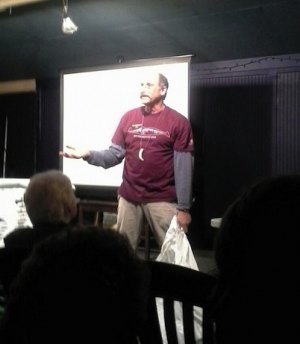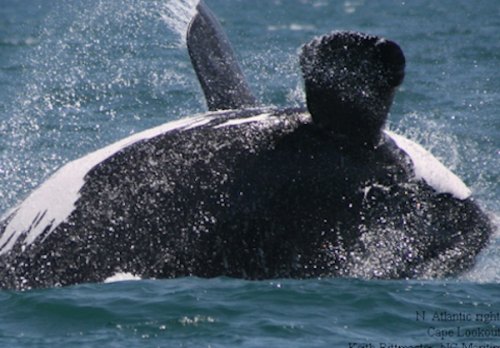A Whale of a Presentation
What kind of a man are you? Don’t you even like dolphins?"
--- Anthony Quinn as Zorba the Greek by Nikos Kazantzakis
Everyone likes dolphins, not to mention the rest of the 105 species of cetaceans found worldwide. So it’s not surprising that an enthusiastic crowd turned out at the Deepwater Theater Monday evening for a slide show on coastal whales in North Carolina given by Keith Rittmaster, Natural Science Curator of the N.C. Maritime Museums.
Here’s what it was like: Have you ever been on a boat – perhaps one of our ferries – and a pod of dolphins suddenly pops out of the water so close alongside that you could almost touch them? Everybody runs to that side, squealing with excitement as, without realizing it, they bond into a special group through the shared experience.
The first thing you notice about Keith when he takes the stage is his almost child-like excitement about his subject matter. His sense of wonder is infectious. He must have given this talk dozens of times and yet, like a sudden dolphin appearance, it never gets old.
While the presentation was highly informative, a major part of its message was how little is actually known about these marvelous animals. Much of Rittmaster’s job involves photo identification of cetaceans. The underside of most whales’ tails have a black and white pattern which, like fingerprints, are unique to each individual. Dolphins, on the other hand, are identified by the shape, nicks and scars of their dorsal fins.

Rittmaster said that 33 of the 105 whale species are found in N.C. coastal waters. Historically, three of these – right whales, sperm whales and dolphins – were hunted along our coast from Cape Hatteras to Cape Lookout, primarily for their oil. Right whales were so named because they were considered the “right” whale to hunt – mainly because they float after they are killed but also because of their valuable blubber layer and their baleen which was used for a variety of things before the development of plastics. While most whale oils were used primarily for light fuel, sperm whale oil was more valuable as a lubricant and was used, for instance, as an early transmission fluid in Rolls Royces. Dolphins were hunted for the very precious oil found in their lower jaws for help in producing sound signals. That oil was used for such purposes as lubricating Swiss watches.
Part of Keith’s job is to examine the numerous whales that end up on our beaches each year, more than half of which are bottle-nosed dolphins. Once beached, these animals never survive. While in many cases the cause of the problem is obvious such as entanglement in human refuse like fishnets, most of the causes remain a mystery.
Since a significant amount of whale deaths are caused by human activities (56% of the humpback whales observed show signs of entanglement), Keith and his colleagues have been working hard to raise awareness of the need to keep refuse such as monofilament fishing lines out of our waters. He even took a brief commercial break to encourage the audience to purchase "Protect Wild Dolphins" license plates, the proceeds of which help to fund his conservation efforts.
Among the many “show and tell” items Keith brought was a large mass of rope and monofilament found on Ocracoke's beach, and he also showed slides of entangled whales and slides of plastic items taken from the corpses of beached whales. When he showed one slide of a 4-month old nursing dolphin, found with its mother, which died in his arms as a result of entanglement, more than a few handkerchiefs erupted in the audience.
But as Keith was delighted to point out, the news is not all bad. When he first began studying the highly endangered right whale 15 years ago there were only 300 left in the world. Now there are about 500. Again, like the continuous beaching of apparently healthy whales, nobody knows why.
At one point in the program, Keith played an audio clip of the sounds dolphins make to stun their prey. He even did an impressive impersonation of the sound himself by forcing air through his cheeks.
I was so captivated by the talk that it was nearly over before I suddenly remembered I’d volunteered to write a story about it for the Current. Yikes! I better start writing stuff down.
1) There are two suborders of whale – Odontocetes or toothed whales (including dolphins) and Mysticetes or baleen whales.
2) The most abundant whales in N.C. waters are the spotted dolphins which are only found several miles offshore.
3) The age of a toothed whale can be determined by slicing a tooth and counting the annual growth lines like rings in the cross section of a tree.
4) Usually when whales are spotted they are accompanied by dolphins for unknown reasons.
Near the end of the program, Keith told of his periodic trips to Alaska serving as a scientific observer aboard oil company exploration vessels to ensure that whales are protected from damage as a result of sonic probes.
After the show almost everyone had questions. And although it was obvious that few people might be better able to answer them than Keith Rittmaster, his response quite frequently was, “That’s a really good question and I don’t know the answer.”
It’s a mark of a good teacher when the students are left with questions. So if I’m allowed to quote one more Greek:
“True wisdom comes to each of us when we realize how little we understand about life, ourselves and the world around us.” -- Socrates
Over 50 adults and children attended the NC Coastal Whales presentation, 11 of whom were Ocracoke middle school students who earned extra credit from their science teacher, Patricia Piland.
Special thanks to David Mickey and Sue Dayton who organized the event, and to Ocracoke Alive for hosting it. A gift basket with goodies donated by Roxy's Antiques, Books to Be Red, Ocracoke Restoration, and Village Craftsmen was raffled at the presentation. Raffle ticket proceeds benefited the NC Monofilament Recovery and Recycling Program.
Find out more about the work Keith does through the NC Maritime Museum's Cape Lookout Studies program at www.capelookoutstudies.org




